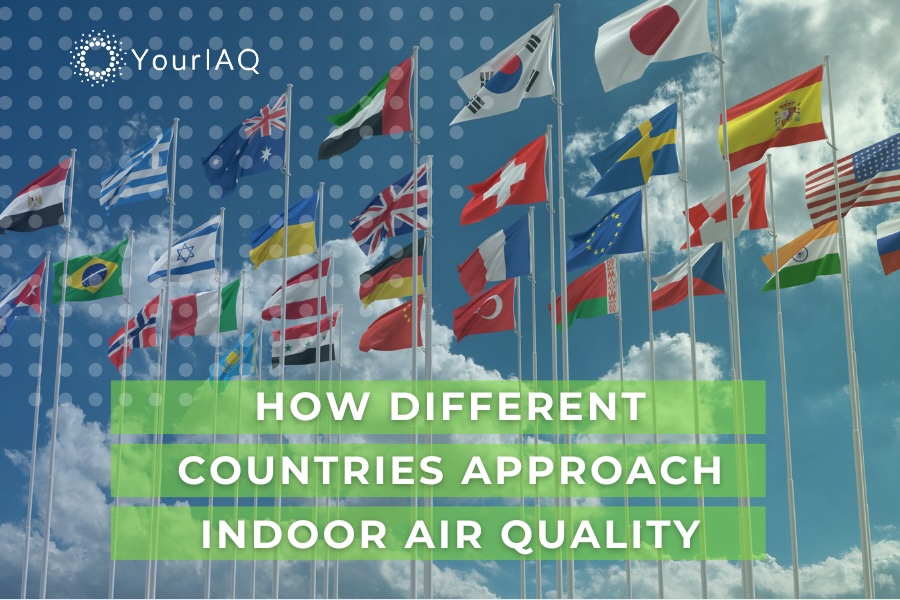
Ah, air. It’s invisible, essential, and often taken for granted. But the quality of that air, especially indoors, varies greatly depending on where you live. Today, we embark on a journey to explore how different countries approach indoor air quality (IAQ), peeking into diverse strategies and challenges. But wait, we won’t stop at national borders! We’ll also touch upon global air quality standards and guidelines, painting a broader picture of our shared quest for clean air.
Why We Should Care About Air Quality
Global air quality isn’t just about comfort; it’s a critical public health issue. According to the World Health Organization (WHO), 99% of the global population breathes air exceeding WHO air quality guidelines. This polluted air, both outdoor air and indoor air, leads to an estimated 7 million premature deaths annually, disproportionately impacting developing countries.
So, why does global air quality matter?
- Climate Change: Many air pollutants are also greenhouse gases, exacerbating climate change and creating a vicious cycle.
- Sustainable Development: Poor air quality hinders economic development and slows progress towards sustainable development goals.
- Public Health: Air pollution contributes to a range of respiratory illnesses, heart disease, and even cognitive decline.
See also:
- Understanding the Relationship Between Climate Change and Indoor Air Quality
- Indoor Air Quality Regulation: What Are the Standards?
- Home Building Standards and Indoor Air Quality
Indoor and Outdoor Air – A Shared Concern
While we often think of outdoor air pollution as the main culprit, indoor air quality plays a significant role in global health challenges. Dr. Maria Neira, Director of the Department of Environment, Climate Change and Health at WHO, emphasizes, “Indoor air pollution is a major environmental health risk, causing millions of deaths each year. It’s crucial to address both indoor and outdoor air quality for a holistic approach to healthier living.”
In fact, the WHO estimates that over 3.8 billion people still rely on unhealthy cooking practices with solid fuels, contributing significantly to indoor air pollution and respiratory illnesses. Moreover, smoke from wildfires in California and Australia led to hazardous air quality conditions inside homes, prompting public health warnings and highlighting the need for better filtration systems and improved building envelope sealing. This highlights the interconnectedness of indoor and outdoor air quality, with outdoor pollutants infiltrating buildings and indoor sources adding to the overall burden.
Understanding this connection is crucial, as it emphasizes the need for comprehensive solutions that address both outdoor air and indoor air simultaneously. This holistic approach is reflected in global organizations like the World Health Organization (WHO) setting air quality standards and guidelines that encompass both indoor and outdoor environments.
Challenges and Solutions Across the Globe
As we delve into the diverse approaches to indoor air quality around the world, it’s crucial to acknowledge the unique challenges different regions face. Factors like climate, geography, and development levels paint a complex picture, often influenced by rapid industrialization, urbanization, and even varying environmental regulations.
One key resource in understanding these disparities is the Global Air Quality Index. This ranking system provides a valuable snapshot of air quality levels across the globe, highlighting both success stories and areas needing improvement. It serves as a powerful reminder of the interconnectedness of this issue and underlines the urgent need for global collaboration.
Now, let’s take a look at some real-life examples of how countries all over the world found solutions to air pollution (both indoor and outdoor).
India

India faces a significant challenge with indoor air pollution, primarily due to widespread dependence on traditional cooking methods and inadequate ventilation. While cultural practices like tandoor ovens contribute to the issue, the government and several initiatives are actively working towards cleaner air within homes:
Initiatives and Solutions:
- National Clean Air Programme (NCAP): Launched in 2019, this program aims to reduce PM2.5 and PM10 pollution by 20-30% by 2024. While primarily focused on outdoor air, it acknowledges the link with indoor air and encourages research and interventions.
- Improved Cookstoves: Various non-profit organizations and private companies are working on developing and promoting improved cookstoves with lower emissions and better fuel efficiency. Examples include smokeless tandoors and biodigester. Other India’s initiative to improve air quality includes smoke-free furnaces and sales tax on cars.
- Ventilation Awareness: Campaigns are raising awareness about the importance of proper ventilation in homes, encouraging practices like opening windows and using chimneys/exhaust fans while cooking.
United States and Germany

While developed nations like Germany and the US have established strict air quality standards, maintaining clean air presents ongoing challenges.
Dr. Richard Fuller, Chair of the Clean Air Alliance, highlights this reality: “Even developed nations face difficulties in upholding clean air, particularly with factors like accelerating urbanization and shifting weather patterns.” This sentiment is echoed by the Environmental Protection Agency (EPA), which acknowledges persistent struggles with pollutants like ozone and fine particulate matter (PM2.5).
However, both the US and Germany are actively tackling these challenges. Their efforts focus on reducing industrial emissions, a significant source of air pollution, and promoting cleaner energy sources. These initiatives, while crucial, underscore the complexity of maintaining clean air even with established regulations and resources.
Read more: The 15 U.S. Cities With the Worst Indoor Air Pollution
China

Rapid urbanization and reliance on solid fuels pose significant challenges. The World Bank estimates that the economic cost of air pollution in developing countries reaches $8.1 trillion.
In China, for example, rapidly developing cities grapple with smog that seeps indoors. Here, innovative solutions like advanced air filtration systems and tight building envelopes are gaining traction. However, a recent study by Greenpeace East Asia revealed that 46% of Chinese cities still exceed WHO air quality guidelines. Collaboration and knowledge sharing between countries are crucial for sustained progress.
Denmark

Denmark is famous for its cozy and comfortable “hygge” lifestyle. However, it poses a unique challenge when it comes to indoor air quality. Closed windows and warm interiors, while creating a quintessential hygge atmosphere, also trap stale air and moisture, which leads to potential health problems. But the Danes are not giving up on this challenge. They are addressing it with their characteristic innovation and dedication.
Building Green from the Ground Up:
- Strict Building Codes: Denmark boasts some of the world’s most stringent building regulations, prioritizing energy efficiency and air quality. New construction mandates high-performance ventilation systems with heat recovery technology, ensuring fresh air without sacrificing energy conservation.
- Passive House Design: Many new Danish homes adopt the Passive House standard, emphasizing airtightness and efficient ventilation systems, minimizing energy needs while maintaining healthy air quality.
Japan

Once shrouded in smog, Japan has undergone a remarkable transformation, becoming a global leader in managing both outdoor and indoor air quality. Its journey offers valuable insights for countries grappling with similar challenges.
From Minamata to National Action:
The infamous Minamata mercury poisoning incident of the 1950s, where industrial emissions contaminated waterways and caused widespread neurological damage, served as a wake-up call for Japan. This tragedy, along with growing public concern about air pollution after the Second World War, triggered a national commitment to cleaner air, encompassing both outdoor and indoor environments.
Cultural Habits for Cleaner Homes:
Japanese cultural norms also play a significant role. The emphasis on cleanliness translates to regular ventilation and housekeeping practices, reducing indoor air pollution sources. The widespread use of traditional tatami mats, known for their natural air purification properties, further contributes to healthier indoor environments.
Lessons for the World:
Japan’s multifaceted approach offers valuable lessons for other countries seeking cleaner air. Adapting relevant strategies, like stricter regulations, technological advancements, and public awareness campaigns, significantly improves air quality both indoors and outdoors. Embracing local cultural aspects and tailoring solutions to specific challenges are key to creating healthier living environments for all.
Global Comparisons and Collaboration
While approaches differ, the goal of healthy indoor air remains universal. Leading the charge are countries like Germany, with stringent regulations on building materials and ventilation standards. Others, like Singapore, focus on public awareness campaigns and readily available air quality data. International organizations like the World Health Organization (WHO) play a crucial role in setting global guidelines and facilitating knowledge sharing between countries.
Role of WHO
The World Health Organization (WHO) plays a crucial role in protecting global health, and that includes setting benchmarks for clean air. Their Air quality guidelines establish concentration limits for various pollutants, aiming to safeguard public health worldwide. These guidelines serve as a vital reference point for countries as they develop their own air quality policies and regulations.
Here’s a table summarizing the annual average limits recommended by the WHO for key pollutants:
| Pollutant | WHO Annual Average Limit (µg/m³) |
| PM2.5 (fine particulate matter) | 10 |
| PM10 (coarse particulate matter) | 20 |
| Ozone (O₃) | 40 |
| Nitrogen Dioxide (NO₂) | 10 |
| Sulfur Dioxide (SO₂) | 40 |
Understanding the numbers:
- PM2.5 and PM10: These particulate matter are tiny airborne particles linked to numerous health problems, including respiratory illnesses and cardiovascular diseases. Lower values indicate cleaner air.
- Ozone (O₃): This gas irritates the lungs and triggers respiratory issues, especially during high ozone days. Reduced levels contribute to better air quality.
- Nitrogen Dioxide (NO₂): Primarily emitted from traffic and industrial processes, NO₂ exposure harms the respiratory system. Lower concentrations signify cleaner air.
- Sulfur Dioxide (SO₂): Mainly released from industrial activities, SO₂ irritates the respiratory system and contributes to acid rain. Limiting its presence improves air quality.
Improvement of Air Quality
Despite the challenges, there are beacons of hope. Cities like Beijing and London have shown dramatic improvements in both outdoor air and indoor air quality through ambitious clean air plans and targeted interventions.
Take Beijing’s ambitious “Clean Air Action Plan,” which has led to significant reductions in PM2.5 concentrations. London’s ultra-low emission zone is reducing traffic-related pollutants. These success stories offer valuable lessons and inspiration for other countries on the path to cleaner indoor air.
Policy Options for Air Quality Management
To improve air quality and meet global standards, countries must adopt comprehensive air quality management strategies. These strategies may include a combination of regulatory measures, technological advancements, public awareness campaigns, and international collaborations.
Key policy options for air quality management include the following:
- Emission Reduction Measures: Implementing strict regulations on industrial emissions, vehicle emissions, and power plant emissions can significantly reduce air pollution levels.
- Transition to Clean Energy Sources: Promoting the use of clean and renewable energy sources such as solar and wind power can reduce reliance on fossil fuels and decrease air pollution.
- Improving Transportation Systems: Encouraging the use of public transportation, promoting electric vehicles, and implementing traffic management strategies can help reduce vehicular emissions.
- Enhancing Industrial Practices: Encouraging industries to adopt cleaner production techniques, implement pollution control measures, and prioritize sustainable practices can contribute to improved air quality.
- Public Awareness and Education: Raising awareness about the health impacts of air pollution and promoting sustainable behaviors can empower individuals to take action and support air quality improvement initiatives.
- International Collaboration: Engaging in international collaborations and sharing best practices can facilitate knowledge exchange and foster global efforts toward improving air quality.
Read further: What Is an Air Quality Alert and Why Does It Matter?
Individual Action and Collective Impact
Remember, indoor air quality is not just a national issue; it’s a global concern. By understanding diverse approaches, adhering to international standards, and taking individual action, we can breathe easier together. Our quest for cleaner air requires collaboration, knowledge sharing, and a commitment to collective action.
Global Air Quality Standards: FAQs
Is my indoor air quality worse than outdoor air quality?
It depends! While outdoor air often gets the blame, a 2020 study by the Environmental Protection Agency (EPA) found that indoor air pollutant levels can be 2-5 times higher than outdoor levels. Understanding your specific situation and potential indoor pollutants is key.
What are some simple ways to improve my indoor air quality?
Open windows regularly, use exhaust fans in kitchens and bathrooms, invest in air purifiers, and choose low-VOC cleaning products and furniture.
How can I learn more about my country’s approach to indoor air quality?
Check your government’s environmental agency website or consult international organizations like the WHO for regional information and resources.
What can I do to advocate for cleaner air, both indoors and outdoors?
Support clean air policies, raise awareness among friends and family, and consider joining advocacy groups working for cleaner air solutions.
Can individual actions really make a difference?
Absolutely! Every effort, from choosing cleaner products to supporting clean air initiatives, contributes to a healthier planet and cleaner air for everyone.







